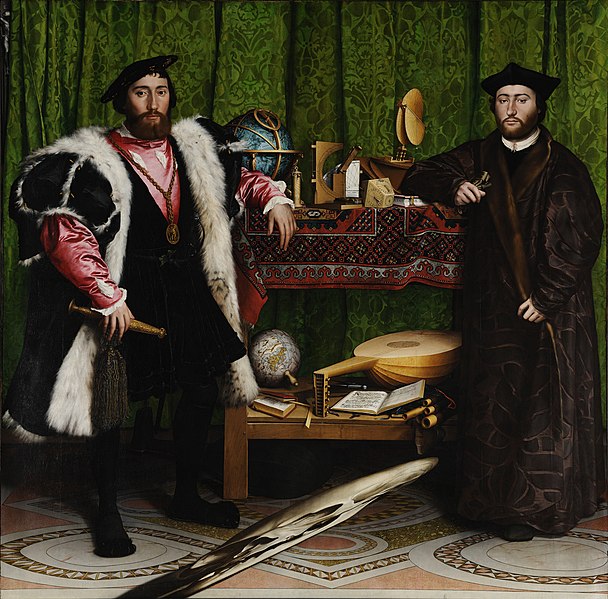Vocab Assignment
Sfumato- Denotes a painting technique that there are no harsh outlines present. Which means that the areas blend into one another through miniscule brushstrokes, which makes for a rather hazy, albeit more realistic, depiction of light and color. Sfumato was something that da Vinci was very well known for.

Leonardo da Vinci's Mona Lisa.
Pentimento- Describes a part of a picture that has been over painted by the artist which has become visible again, often as a ghostly outline, because the superimposed layer of pigment had become semi-transparent with age. Pentimento is used to tell if a painting was an original or not.

This is a portrait of Queen Elizabeth I, by an unknown artist in the late 1580s. It appears that there used to be a snake in her hand, rather that the feather that is painted there now.
Chiaroscuro- Refers to the modeling of volume by depicting light and shade by contrasting them boldly. This is one means of strengthening an illusion of depth on a two-dimensional surface. Chiaroscuro was an important topic among artists of the Renaissance movement.

Rembrandt Harmensz. van Rijn (Dutch, 1606-1669), Self Portrait at Twenty-Two 1628, Rijksmuseum, Amsterdam, Netherlands.
Contour Line - Line that surrounds and defines the edges of a subject, giving it shape and volume. In contour drawing contour lines are used to represent subject matter in a three-dimensional quality, indicating the thickness as well as height and width of the forms it describes.

Henri Gaudier-Brzeska (English, born France, 1891-1915), A Wolf. 1913, Tate Gallery, London.
Complementary Color Scheme - A set of colors that are used in an artwork that are directly opposite each other on the color wheel, such as red and green, blue and orange, and violet and yellow. Christmas is a well known time when the red and green complementary color scheme is used a lot.

Marie-Lucie Nessi-Valtat Still Life Twentieth Century
Analogous Color Scheme - A set of colors that are used in an artwork which include any two or more colors that are next to each other on the color wheel and are closely related. For example, blue, blue-green, and green all have the color blue in common. Families of analogous colors include warm colors (red, orange, and yellow) and the cool colors (green, blue and violet). Analogous colors are sometimes referred to as adjacent colors. Picasso's blue period used the blue analogous color scheme.

The Tragedy 1903 Pablo Picasso
Monochromatic Color Scheme - A piece of artwork consisting of only a single color or hue; may include it's tints and shades. Monochrome color schemes are used when things are in black and white as well.

Forward Retreat, 1986 Mark Tansey
Iconography - The pictorial representation of a subject, or the collected images (or icons) illustrating a subject - pictures, diagrams, etc. Iconography can mean the description of representational works of art. Also the study of subject matter and symbolism in the visual arts, as in collections of pictures constituting a complete visual record of a subject, or visual dictionary.

The Ambassadors, Hans Holbein the Younger, 1533
This work's iconography remains the subject of debate.
Iconology- The branch of knowledge which deals with the subject of icons (or images); also the subject matter of this study, icons collectively, or as objects of investigation.

Robert Campin's Merode Altarpiece (1425-1428)
Iconology of this piece is still debated. Is Joseph making a mousetrap, reflecting a remark of Saint Augustine that Christ's Incarnation was a trap to catch men's souls?
Foreshortening - A way of representing a subject or an object so that it conveys the illusion of depth - so that it seems to thrust forward or go back into space. Foreshortening's success often depends on a point of view or perspective in which the sizes of near and far parts of a subject contrast greatly.

Andrea Mantegna The Lamentation Over the Dead Christ 1480
Crosshatching - Creating tonal or shading effects with closely spaced parallel lines and lines that are placed at an angle across the first.

Albrecht Durer Veil of Veronica 1513
Modernism - An art movement characterized by the deliberate departure from tradition and the use of innovative forms of expression that distinguish many styles in the arts and literature of the late nineteenth and early twentieth centuries.

Hans Hofmann The Gate 1959
Postmodernism - Art, architecture, or literature that reacts against earlier modernist principles as by reintroducing traditional or classical elements of style or by carrying modernist styles or practices to extremes.
Hans Haacke Blue Sail 1964
Picture plane - In perspective, the plane occupied by the surface of the picture - it's frontal boundary. When there is any illusion of depth in the picture, the picture plane is similar to a plate of glass behind which the pictorial elements are arranged in depth. Artists indicate teh supposed distance of subjects beyond the picture plane through the use of changes in the sizes of things, the ways they overlap each other, and (when subjects are placed on the depicted ground, as opposed to flying above it) by positioning them on the area taken up by the depicted floor, ground, or a body of water.

Paul Cezanne Still Life with Apples 1890
Foreground, Middle ground, and Background - The three spatial attributes, foreground is at the bottom, and is close at hand. Middle ground includes the horizon and is in the middle of the picture, and the background goes to infinity and is shown at the top of the picture.

Andrew Wyeth Christina's World 1948
Christina is in the foreground, the field is in the middle ground, and the sky and top of the hill are in the background.
No comments:
Post a Comment